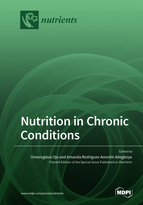Nutrition in Chronic Conditions
A special issue of Nutrients (ISSN 2072-6643). This special issue belongs to the section "Nutrition and Public Health".
Deadline for manuscript submissions: closed (25 September 2022) | Viewed by 85690
Special Issue Editors
Interests: nutrition; prebiotics; diabetes; glycaemic index of food; dietary fibre; gut microbiome
Special Issues, Collections and Topics in MDPI journals
Interests: nutrition; maternal and women’s health; health inequality; equity and diversity; obesity; dairy intake; gestational outcomes; chronic diseases; oral health
Special Issues, Collections and Topics in MDPI journals
Special Issue Information
Dear Colleagues,
The effects of nutrition on chronic conditions, such as diabetes, cardiovascular disease, dementia and stroke, continue to generate interest among researchers. This is based on the fact that diet is a modifiable risk factor for these diseases, which manifest either as single entities or in co-morbid states in individuals and populations around the world. In particular, the prevalence of diabetes and cardiovascular disease is on the increase, especially in developed countries, but also in developing economies, partly due to lifestyle changes, including diet. For example, ischaemic heart disease is the leading cause of death globally. When combined with stroke, they accounted for 15 million deaths in 2015 and are the world’s greatest killers (WHO, 2017). Furthermore, WHO (2016) reported that there were an estimated 422 million adults living with diabetes in 2014. This is significantly higher than the 108 million in 1980, representing a rise in worldwide diabetes prevalence from 4.7% in 1980 to 8.5% in 2014 among the adult population.
These chronic conditions and their associated complications have significant implications for morbidity and mortality, not to mention huge costs to the health services around the world. The composition of the diet, the proportion and types of macronutrients and micronutrients present in the diet are major contributors to these diseases. In addition, the beneficial effects of nutritional interventions have been well documented although differences remain among researchers with respect to their overall impact. The evaluation of the role of nutrition in chronic conditions draws on its effect on body weight and body composition, glycaemic and insulin excursions and vascular remodelling. The effect of the diet in modulating gut microbiota dysbiosis is also an evolving area of research.
Therefore, this Special Issue on “Nutrition and Chronic Conditions” is aimed at examining the effect of nutrition in the development, care and management of chronic conditions. The primary conditions of interests are diabetes, cardiovascular disease, dementia, stroke and inflammatory bowel disease.
Dr. Omorogieva Ojo
Prof. Dr. Amanda Adegboye
Guest Editors
Manuscript Submission Information
Manuscripts should be submitted online at www.mdpi.com by registering and logging in to this website. Once you are registered, click here to go to the submission form. Manuscripts can be submitted until the deadline. All submissions that pass pre-check are peer-reviewed. Accepted papers will be published continuously in the journal (as soon as accepted) and will be listed together on the special issue website. Research articles, review articles as well as short communications are invited. For planned papers, a title and short abstract (about 100 words) can be sent to the Editorial Office for announcement on this website.
Submitted manuscripts should not have been published previously, nor be under consideration for publication elsewhere (except conference proceedings papers). All manuscripts are thoroughly refereed through a single-blind peer-review process. A guide for authors and other relevant information for submission of manuscripts is available on the Instructions for Authors page. Nutrients is an international peer-reviewed open access semimonthly journal published by MDPI.
Please visit the Instructions for Authors page before submitting a manuscript. The Article Processing Charge (APC) for publication in this open access journal is 2900 CHF (Swiss Francs). Submitted papers should be well formatted and use good English. Authors may use MDPI's English editing service prior to publication or during author revisions.
Keywords
- nutrition and co-morbidities
- gut microbiota
- glycaemic index, glycaemic load and diabetes
- nutrition and diabetes
- nutrition and dementia
- nutrition and cardiovascular disease
- nutrition and stroke
- nutrition and inflammatory bowel disease
- pathogenesis of diabetes and other chronic conditions








